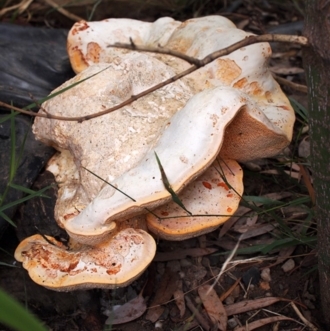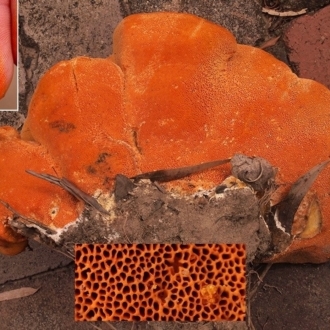Piptoporus australiensis (Curry Punk)
The fruit body is a polypore with a rubbery to corky texture and looking like a thick, shelf-like outgrowth from wood. It may project to about 20 centimetres and be up to 8 centimetres thick at the wood surface. The upper surface is at first white but later staining yellow, orange, or brown and may be smooth, ridged or pitted. When fresh it may weep a yellowish fluid from the lower surface, which is yellow to orange and covered with pores.It readily stains fingers that handle it. With age the upper surface may fade to whitish but the rich colour of the underside persists.
The fruit body has a smell of curry (more so as it ages) and this persists, being detectable in dried, herbarium specimens.
The fruit bodies appear on living or dead wood, especially fire-damaged wood.
The original description of this species (published in 1914) was based on a specimen collected in Queensland but it has been recorded from a wide range of forests, from tropical Queensland, south to Tasmania and South Australia and from south-west Western Australia.
Look-alikes
It should not be possible to confuse this fungus with any other species. Pycnoporus fruit bodies are reddish orange and shelf-like, but thinner, don’t weep and do not smell of curry. Species of Fistulina have fleshy, red to reddish-brown shelf-like, non-weeping, curry-less fruit bodies in which the underside consists of separate, but densely packed, tubes.
Piptoporus australiensis is listed in the following regions:
Species information
- Piptoporus australiensis Scientific name
- Curry Punk Common name
- Not Sensitive
- Local native
- Non-Invasive
- Up to 666m Recorded at altitude
- Machine learning
-
Synonyms
Piptoporus australensis
Follow Piptoporus australiensis
Receive alerts of new sightings
Subscribe














